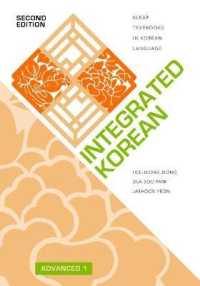- ホーム
- > 洋書
- > 英文書
- > Politics / International Relations
基本説明
Based on the notion that all actors - politicians as well as voters - are only boundedly rational.
Full Description
Most theories of elections assume that voters and political actors are fully rational. While these formulations produce many insights, they also generate anomalies - most famously, about turnout. The rise of behavioral economics has posed new challenges to the premise of rationality. This groundbreaking book provides a behavioral theory of elections based on the notion that all actors - politicians as well as voters - are only boundedly rational. The theory posits learning via trial and error: actions that surpass an actor's aspiration level are more likely to be used in the future, while those that fall short are less likely to be tried later. Based on this idea of adaptation, the authors construct formal models of party competition, turnout, and voters' choices of candidates. These models predict substantial turnout levels, voters sorting into parties, and winning parties adopting centrist platforms. In multiparty elections, voters are able to coordinate vote choices on majority-preferred candidates, while all candidates garner significant vote shares.
Overall, the behavioral theory and its models produce macroimplications consistent with the data on elections, and they use plausible microassumptions about the cognitive capacities of politicians and voters. A computational model accompanies the book and can be used as a tool for further research.
Contents
Acknowledgments xi Chapter One: Bounded Rationality and Elections 1 1.1 Framing and Representations 5 1.2 Heuristics 8 1.3 Aspiration-based Adaptation and Bounded Rationality 12 1.4 Plan of This Book 21 Chapter Two: Aspiration-based Adaptive Rules 23 2.1 ABARs Defined 23 2.2 Some Important Properties of ABARs 33 2.3 The Evidential Status of Aspiration-based Adaptation 46 Chapter Three: Party Competition 52 3.1 Related Work 54 3.2 The Model and Its Implications 56 3.3 Informed and/or Sophisticated Challengers 68 3.4 Robustness Issues 74 3.5 Conclusions 78 Chapter Four: Turnout 80 4.1 The Model 82 4.2 Main Results 85 4.3 Variations in Participation 96 4.4 Conclusions 107 Chapter Five: Voter Choice 109 5.1 The Model 112 5.2 The Endogenous Emergence of Party Affiliation 116 5.3 Misperceptions 121 5.4 Retrospection and Prospection Combined 122 5.5 Voter Sophistication and Electoral Outcomes 124 5.6 Institutions and Unsophisticated Retrospective Voters 128 5.7 Conclusions 130 Chapter Six: An Integrated Model of Two-Party Elections 132 6.1 Full Computational Model for Two Parties 134 6.2 Some Results of the Basic Integrated Model 138 6.3 The Choices of Voters 141 6.4 Party Location 145 6.5 Turnout 148 6.6 New Questions 152 6.7 Conclusion 159 Chapter Seven: Elections with Multiple Parties 161 7.1 Extending Our Results to Multiple Parties 161 7.2 Multicandidate Competition and Duverger's Law 166 7.3 The Model and Simulation Results 173 7.4 An Intuition 180 7.5 ABARs and Dynamic Stability 183 7.6 Model Meets Data 184 Chapter Eight: Conclusions: Bounded Rationality and Elections 191 8.1 Testing the Theory 194 8.2 Normative Considerations: Voter Error and Systemic Performance 196 8.3 Extensions 198 Appendix A: Proofs 205 Appendix B: The Computational Model 215 B.1 Overview 215 B.2 Graphical Model 216 B.3 Batch Model 229 Bibliography 233 Index 249

![Nemuki+ 2023年3月号 [雑誌] Nemuki+](../images/goods/ar2/web/eimgdata/EK-1400516.jpg)





